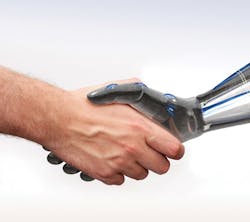Opportunities arise because robots have always been targeted at applications in which there’s a high demand for flexibility, there is a difficult environment, or there is a need for highly repetitive moves, very precise positioning or high speed, explains Dan Throne, sales and marketing manager for vendor Bosch Rexroth Corp.’s (www.boschrexroth-us.com) electric-drives-and-controls division, Hoffman, Estates, Ill. “So the new application of robotics in the packaging and solar markets has been increasing significantly, because they (robots) fill many of the markets’ needs.”
That’s good news for robotics vendors, some of whom have already made inroads into non-automotive areas. “We’ve been supplying [robots, software and controls for] solar for 10 years. But three years ago, we saw a need for automated handling of solar cells.” observes John Dulchinos, president and chief executive officer of Adept Technology Inc. (www.adept.com), Pleasanton, Calif. The use of robots minimizes breakage of the extremely thin cells, which account for approximately 50 percent of a solar panel’s cost, he explains. Throne adds that because solar technologies change rapidly, “robotics is helping provide the flexibility for testing of the panels and arrays.”
For packaging, Throne notes that high-speed Delta or parallelogram robots are used in primary packaging through load wrappers. For secondary packaging, he says robots find use in top-load cartoners or case packing of products. “We have also seen more palletizing companies using five-axes articulated or gantry-type robots, because of increased speeds and loads of large-volume lines today.”
Clay C. Cooper agrees that recent developments enable robots to achieve higher speeds with high payloads—and adds that those developments are directed not only at food-industry applications, but generally, to manufacturing. “They are primarily being used in production lines set up to produce a variety of products,” says Cooper, engineering manager for Applied Robotics Inc. (www.appliedrobotics.com), Glenville, N.Y. For example, a new high-speed meat gripper is being used in processing lines “in place of labor, which not only saves money, but also meets needs in locations where availability of labor is scarce.”
Robots with eyes
Vision appears to be an attribute of robots that will also enhance robots’ value beyond just automotive. For example, SmartTCP Inc. (www.smarttcp.com), of Farmington Hills, Mich., focuses on welding solutions for small batch operations. “The automatic-welding solution for fabricators is a multi-billion-dollar potential market,” asserts Efi Lebel, SmartTCP’s chief executive officer.
Regardless of use and besides becoming faster, robots are becoming more reliable and accurate than ever before, declares Jeff Burnstein, president of the Ann Arbor, Mich.-headquartered Robotics Industries Association (www.ria.org). “You’re also seeing developments that allow robots to work with people more than before, side-by-side with people on an assembly line.” That’s possible, he indicates, due to more safety being built into robots’ controllers, “so you don’t have to put fencing and safety around the robotic cell. This is a trend to watch for.”
You even could argue the new technologies are safer than old physical barriers, says Joe Campbell, vice president of sales and marketing for ABB Robotics NA (www.abb.com/robots), Auburn Hills, Mich. “The way the technology is deployed allows you to declare safe, warning and danger zones around the robot’s work envelope.” That helps reduce the robot’s footprint on the factory floor, he notes. “The reduction is space-application specific, but 30 percent to 40 percent is not uncommon.”
The new safety-enhancing solution, which precludes hard barriers such as fencing, allows operators to directly interact with robots, Campbell adds. That characteristic should make robots attractive in many industrial sectors, not just automotive.
C. Kenna Amos, [email protected], is an Automation World Contributing Editor.
Bosch Rexroth Corp.
www.boschrexroth-us.com
Adept Technology Inc.
www.adept.com
Applied Robotics Inc.
www.appliedrobotics.com
SmartTCP Inc.
www.smarttcp.com
Robotics Industries Association
www.ria.org
ABB Robotics NA
www.abb.com/robots
Subscribe to Automation World's RSS Feeds for Columns & Departments
About the Author
C. Kenna Amos
Contributing Editor

Leaders relevant to this article:
